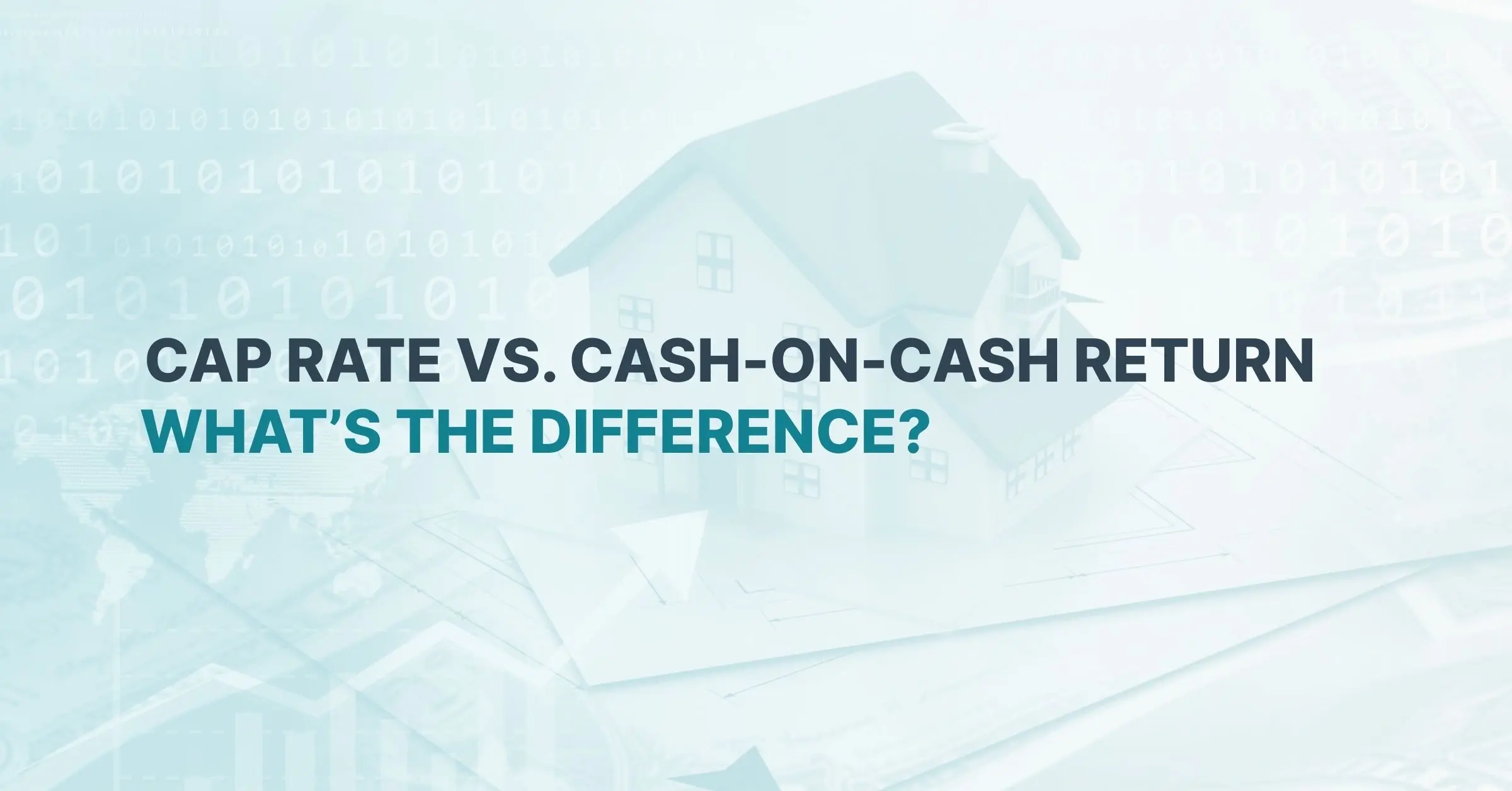Disclaimer: PropStream does not offer investment advice or profit promises. This article is for educational purposes only. Consult a financial professional before investing in real estate.
|
Key Takeaways:
|
Most rental properties are financed. But at what point do they become overleveraged?
Try PropStream for 7 Days Free!
As an investor, that’s a question you must ask before taking out a mortgage. Fortunately, there’s a quick way to see whether a property will generate enough income to cover loan payments. It’s called the debt-service coverage ratio (DSCR), a metric lenders use when underwriting loans.
Read on to learn how to calculate DSCR, its pros and cons, how to improve it, and more.
Table of Contents |
What Is DSCR in Real Estate?
.webp?width=1252&height=834&name=outboundmarketing%20(4).webp)
Debt-service coverage ratio (DSCR) measures how easily a property’s rental income can cover its debt obligations. The higher the ratio, the better.
How to Calculate DSCR
To calculate DSCR, you must divide a property’s net operating income (NOI) by its total debt service. Here’s the formula:
|
DSCR = Net Operating Income (NOI) / Total Debt Service Where:
|
For example, let’s say a rental property has an NOI of $1,500 and a monthly mortgage payment of $1,000. In this case, the DSCR would be 1.5 ($1,500 / $1,000).
Here’s how to interpret different DSCR scores:
- Anything over 1.0 means the property can cover its debt service.
- Anything under 1.0 means the property can’t cover its debt service.
- Exactly 1.0 means the property is breaking even.
Why DSCR Matters for Real Estate Investors
As a real estate investor, knowing how to calculate DSCR is helpful in a few ways.
For one, many lenders require properties to meet a minimum DSCR to qualify for financing. In most cases, it’s a DSCR of at least 1.2. By calculating DSCR upfront, you can rule out properties that won’t qualify.
However, understanding a property’s DSCR also helps you gauge investment risk. Regardless of whether a DSCR passes a lender’s standards, it’ll tell you whether the deal will be cash-flow positive and by how much, which, in turn, helps you determine its long-term sustainability.
Finally, a strong DSCR can help you qualify for multiple loans on multiple properties. As long as each property can cover its debt service, some lenders don’t care how many loans you have.
What Is a DSCR Loan?
A DSCR loan is a real estate loan qualified based on the property’s DSCR rather than the borrower’s personal income. This makes them ideal for self-employed investors who may have irregular income or who’ve exhausted their conventional financing options.
For example, most traditional lenders will only lend to you if you maintain a debt-to-income ratio (DTI) under 36%. That means if your debt rises above 36% of your income, you may not qualify for a mortgage. However, DSCR lenders focus on the property’s income. So long as it can cover the debt service, you’re likely to qualify for DSCR financing, regardless of your DTI.
Most DSCR lenders require:
- A minimum DSCR of 1.2
- A credit score of at least 620
- A down payment of 20-30%
However, exact loan requirements vary by lender, property, and borrower profile.
Pros and Cons of Using DSCR as a Metric
As handy as DSCR can be in quickly assessing rental deals, it has its pros and cons:
Pros |
Cons |
| Simple: DSCR is an easy calculation to do by hand. It doesn’t involve complex formulas. | Ignores future risks: DSCR is based on current or projected income. It doesn’t account for unexpected vacancies, maintenance spikes, or market downturns. |
| Objective: DSCR tells you definitively whether a property can cover its debt payments on its own or not. There’s no guesswork. | Incomplete profit measure: DSCR doesn’t account for capital appreciation, tax benefits, or other investment returns. |
| Widely used: DSCR is widely used by lenders and investors, making it easier to compare different deals. | Relies on accurate NOI: Small errors in calculating NOI can lead to a misleading DSCR and unrealistic cash flow expectations. |
4 Tips for Improving DSCR Before Investing
To increase a property’s DSCR, here’s what you can do:
1. Increase Rental Income
A property’s DSCR is tied directly to NOI, which is tied directly to rental income. The higher your rental income, the higher your DSCR (all else equal). Some ways to maximize rent include:
- Raising rent to market rates (if they’re not there already).
- Add amenities to justify rent increases (e.g., pool, pavilion, etc.).
- Collect extra rent from parking fees, laundry, storage, etc.
2. Lower Operating Expenses
NOI is also tied directly to operating expenses. The lower your operating expenses, the higher your NOI and DSCR by extension (all else equal). Here’s how to lower your operating expenses:
- Make energy-efficient upgrades (e.g., LED bulbs, smart thermostats, etc.).
- Lower vacancy rates with aggressive marketing and leasing incentives.
- Shop around for lower insurance and property management rates.
- Perform regular preventative maintenance to minimize costly repairs.
3. Refinance for Better Loan Terms
Another way to boost a property’s DSCR is to lock in better loan terms that lower your debt service. For example, you could refinance to a loan with a:
- Lower interest rate
- Longer loan term
- Larger down payment
Each of these can lower your monthly debt payment to increase a property’s DSCR.
4. Target Properties with Strong Cash Flow Potential
Some properties naturally offer a higher DSCR because they:
- Are located in high-demand areas
- Have a history of stable cash flow
- Are in good condition and don’t need excessive repairs
Aim for properties like these to maximize DSCR before you invest.
Determine a Property’s Estimated DSCR with PropStream
Ultimately, DSCR can help you assess a property’s performance. Whether you want to optimize operations for a rental you already own or assess a deal before investing, DSCR is one of the first calculations you should make.
With PropStream, you can quickly estimate a property’s value, mortgage payment, and potential rental income, allowing you to determine NOI and DSCR quickly.
Once you’ve found some promising rental leads, save them to a marketing list, perform a skip trace, and start your marketing campaign in one convenient location.
Try PropStream for 7 Days Free—Start Estimating Your Investment Returns
Frequently-Asked Questions (FAQs)
What is DSCR in real estate?
DSCR (debt-service coverage ratio) measures how well a property’s net operating income covers its mortgage obligations.
How do you calculate DSCR for a rental property?
Divide the property’s net operating income (NOI) by its total debt service payment (including principal and interest). You can do this on an annual or monthly basis.
What is a good DSCR in real estate?
Most lenders consider a DSCR of at least 1.2 acceptable, as it gives the property some extra financial cushion to absorb downturns.
What is a DSCR loan, and how does it work?
A DSCR loan qualifies borrowers based on the property’s DSCR rather than the investor’s personal income. This makes them ideal for investors with irregular income or who’ve exhausted their conventional financing options.
What happens if a property’s DSCR is below 1.0?
A DSCR below 1.0 means the property doesn’t generate enough income to cover its debt, which means it's losing money each month (aka negative cash flow).
How can I improve a property’s DSCR?
You can improve a property’s DSCR by raising its rental income, lowering operating expenses, or refinancing for better loan terms.
Subscribe to PropStream's Newsletter


